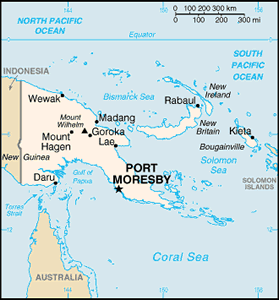The Geography of Papua New Guinea
The Geography of Papua New Guinea
Papua New Guinean Geography
Location: Oceania, group of islands including the eastern half of the island of New Guinea between the Coral Sea and the South Pacific Ocean, east of Indonesia
Geographic coordinates: 6 00 S, 147 00 E
Map references: Oceania
Area: total: 462,840 sq km land: 452,860 sq km water: 9,980 sq km
Area - comparative: slightly larger than California
Land boundaries: total: 820 km border countries: Indonesia 820 km
Coastline: 5,152 km
Maritime claims: measured from claimed archipelagic baselines territorial sea: 12 nm continental shelf: 200 m depth or to the depth of exploitation exclusive fishing zone: 200 nm
Climate: tropical; northwest monsoon (December to March), southeast monsoon (May to October); slight seasonal temperature variation
Terrain: mostly mountains with coastal lowlands and rolling foothills
Elevation extremes: lowest point: Pacific Ocean 0 m highest point: Mount Wilhelm 4,509 m
Natural resources: gold, copper, silver, natural gas, timber, oil, fisheries
Land use: arable land: 0.49% permanent crops: 1.4% other: 98.11% (2005)
Irrigated land: NA
Natural hazards: active volcanism; situated along the Pacific "Ring of Fire"; the country is subject to frequent and sometimes severe earthquakes; mud slides; tsunamis
Environment - current issues: rain forest subject to deforestation as a result of growing commercial demand for tropical timber; pollution from mining projects; severe drought
Environment - international agreements: party to: Antarctic Treaty, Biodiversity, Climate Change, Climate Change-Kyoto Protocol, Desertification, Endangered Species, Environmental Modification, Hazardous Wastes, Law of the Sea, Marine Dumping, Ozone Layer Protection, Ship Pollution, Tropical Timber 83, Tropical Timber 94, Wetlands signed, but not ratified: none of the selected agreements
Geography - note: shares island of New Guinea with Indonesia; one of world's largest swamps along southwest coast


